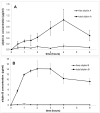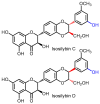Chirality Matters: Biological Activity of Optically Pure Silybin and Its Congeners
- PMID: 34360650
- PMCID: PMC8346157
- DOI: 10.3390/ijms22157885
Chirality Matters: Biological Activity of Optically Pure Silybin and Its Congeners
Abstract
This review focuses on the specific biological effects of optically pure silymarin flavo-nolignans, mainly silybins A and B, isosilybins A and B, silychristins A and B, and their 2,3-dehydro derivatives. The chirality of these flavonolignans is also discussed in terms of their analysis, preparative separation and chemical reactions. We demonstrated the specific activities of the respective diastereomers of flavonolignans and also the enantiomers of their 2,3-dehydro derivatives in the 3D anisotropic systems typically represented by biological systems. In vivo, silymarin flavonolignans do not act as redox antioxidants, but they play a role as specific ligands of biological targets, according to the "lock-and-key" concept. Estrogenic, antidiabetic, anticancer, antiviral, and antiparasitic effects have been demonstrated in optically pure flavonolignans. Potential application of pure flavonolignans has also been shown in cardiovascular and neurological diseases. Inhibition of drug-metabolizing enzymes and modulation of multidrug resistance activity by these compounds are discussed in detail. The future of "silymarin applications" lies in the use of optically pure components that can be applied directly or used as valuable lead structures, and in the exploration of their true molecular effects.
Keywords: Silybum marianum; chirality; dehydroflavonolignan; diastereomer; flavonoid; flavonolignan; isosilybin; milk thistle; silibinin; silybin; silychristin; silydianin; silymarin.
Conflict of interest statement
The author declares no conflict of interest.
Figures













Similar articles
-
Silybin and its congeners: from traditional medicine to molecular effects.Nat Prod Rep. 2022 Jun 22;39(6):1264-1281. doi: 10.1039/d2np00013j. Nat Prod Rep. 2022. PMID: 35510639 Review.
-
The study of flavonolignan association patterns in fruits of diverging Silybum marianum (L.) Gaertn. chemotypes provides new insights into the silymarin biosynthetic pathway.Phytochemistry. 2017 Dec;144:9-18. doi: 10.1016/j.phytochem.2017.08.013. Epub 2017 Sep 1. Phytochemistry. 2017. PMID: 28863306
-
Chemotaxonomic and biosynthetic relationships between flavonolignans produced by Silybum marianum populations.Fitoterapia. 2017 Jun;119:175-184. doi: 10.1016/j.fitote.2017.04.002. Epub 2017 Apr 6. Fitoterapia. 2017. PMID: 28392269 Free PMC article.
-
The effect of milk thistle (Silybum marianum) and its main flavonolignans on CYP2C8 enzyme activity in human liver microsomes.Chem Biol Interact. 2017 Jun 1;271:24-29. doi: 10.1016/j.cbi.2017.04.025. Epub 2017 Apr 27. Chem Biol Interact. 2017. PMID: 28457856
-
Silybin and silymarin--new and emerging applications in medicine.Curr Med Chem. 2007;14(3):315-38. doi: 10.2174/092986707779941159. Curr Med Chem. 2007. PMID: 17305535 Review.
Cited by
-
Preparation of Synthetic and Natural Derivatives of Flavonoids Using Suzuki-Miyaura Cross-Coupling Reaction.Molecules. 2022 Jan 31;27(3):967. doi: 10.3390/molecules27030967. Molecules. 2022. PMID: 35164232 Free PMC article.
-
Phosphodiester Silybin Dimers Powerful Radical Scavengers: A Antiproliferative Activity on Different Cancer Cell Lines.Molecules. 2022 Mar 5;27(5):1702. doi: 10.3390/molecules27051702. Molecules. 2022. PMID: 35268803 Free PMC article.
-
Network Pharmacological Analysis and Experimental Validation of the Effects of Silybin on Proliferation, Migration, and Immunotherapy of Papillary Thyroid Cancer.Endocr Metab Immune Disord Drug Targets. 2024;24(6):672-690. doi: 10.2174/0118715303248000230922185110. Endocr Metab Immune Disord Drug Targets. 2024. PMID: 37855349
-
Determination of the Major Bioactive Component of Silybum marianum in Nutricosmetics by a HPLC Method With Amperometric Detection and UAE Pretreatment.Phytochem Anal. 2025 Jun;36(4):934-942. doi: 10.1002/pca.3478. Epub 2024 Nov 17. Phytochem Anal. 2025. PMID: 39551534 Free PMC article.
-
Silymarin and Inflammation: Food for Thoughts.Antioxidants (Basel). 2024 Jan 14;13(1):98. doi: 10.3390/antiox13010098. Antioxidants (Basel). 2024. PMID: 38247522 Free PMC article. Review.
References
-
- Egea J., Fabregat I., Frapart Y.M., Ghezzi P., Görlach A., Kietzmann T., Kubaichuk K., Knaus U.G., Lopez M.G., Olaso-Gonzalez G., et al. European contribution to the study of ROS: A summary of the findings and prospects for the future from the COST action BM1203 (EU-ROS) Redox Biol. 2017;13:94–162. doi: 10.1016/j.redox.2017.05.007. - DOI - PMC - PubMed
Publication types
MeSH terms
Substances
Grants and funding
LinkOut - more resources
Full Text Sources
Medical

